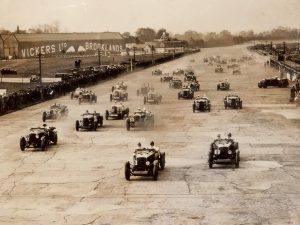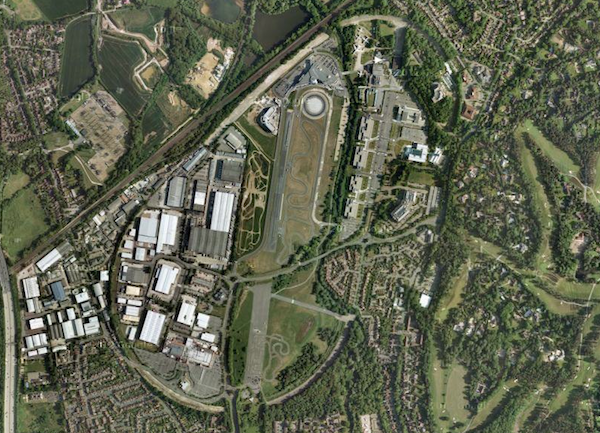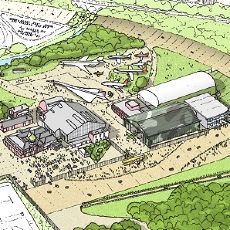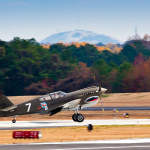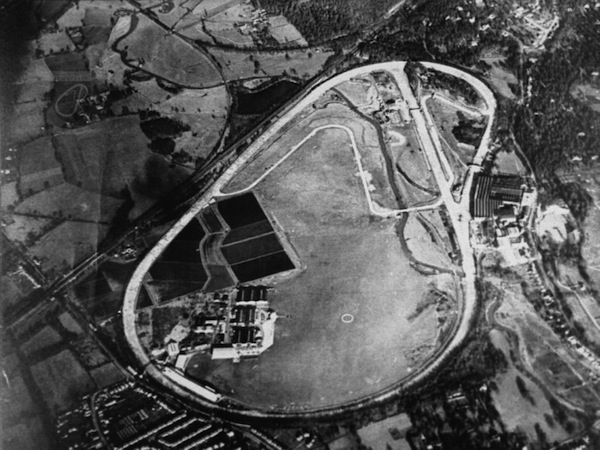
Brooklands, the world’s first purpose built motor speedway, located in Surrey, UK, opened in June 1907. Built at a time when the national speed limit on public roads was 20 MPH and nearly 50% of the planet’s new cars were produced in France, the race track’s construction was partially spurred by fears that Britain’s infant auto-industry would be smothered in the crib by an inability to perform sustained high-speed testing. The track was 2.75 miles long, and featured banked curves which in theory at least, would allow cars to speed through the turns without steering input. In addition to the oval, a bisecting “Finishing Straight” was incorporated in the design, increasing the track length to 3.25 miles, of which 1.25 miles was banked. In its day, Brooklands was the site of many speed records and was the epicenter of British automobile racing, hosting up to 287,000 spectators on race days.
After a hiatus during World War One, motor racing resumed at Brooklands in 1920 with Grand Prix events staged at the site starting in 1926. Brooklands continued to serve as the UK’s center of aviation and motor racing straight through to the beginning of World War Two when racing ceased and the site was fully devoted to the production of military aircraft, most notably Vickers and Hawker who manufactured the Vickers Wellington, Vickers Warwick and Hawker Hurricane. The war effort caused hangars and access roads to be built over several sections of the track and trees were planted on the road course in an effort to camouflage its distinctive outline, though the Germans, mindful of the importance of Brooklands, made sure to bomb it repeatedly over the course of the war.
After the war had ended, the entire site was sold to Vickers-Armstrongs (VA) who greatly expanded their manufacturing operations there, with the Vickers Viking, Valetta, Varsity, Viscount, Vanguard and VC10 being conceived, designed and manufactured at Brooklands with attendant destruction to the original speedway necessitated by larger runways and additional hangars and factory space. When VA was merged into the British Aircraft Corporation (BAC) the facilities were again enlarged with new 60,000 square foot and 99,000 square foot hangars, dubbed “The Abbey” and “The Cathedral” by the locals. The huge factory at Brooklands went on to design and build the ill-fated BAC TSR.2, the One-Eleven and major assemblies for the Concorde.
The marketplace failure of BAC’s planes in particular and the diminishment of Britain’s manufacturing base in general saw the importance and utilization of the massive complex decline in the seventies, with BAC successor corporate entity, British Aerospace ceasing operations at Brooklands altogether in 1988-89. In 1975 following extensive efforts by local historical societies, certain buildings, including the 1907 British Automobile Racing Club’s Clubhouse, the 1911 Flight Ticket Office, the 1932 Brooklands Aero Clubhouse and significant remaining sections of the adjacent speedway were accorded historic landmark status. The Brooklands Museum, housed within the aforementioned historical buildings on the northeast portion of the once-sprawling site began operations in the late eighties and staged regular fly-ins for visiting light aircraft from 1991 to 2003 using the Northern half of the original tarmac runway.
(Image Credit: Google, Bluesky, Digital Globe, Getmapping, plc and Infoterra Ltd)
The already popular 30-acre museum campus hosts over 150,000 visitors a year and has an extensive collection of vintage aircraft and automobiles as well as housing the London Bus Museum. Notable aircraft on display include airworthy reproductions of the Vickers Vimy, Bleriot XI and Sopwith Camel straight through to a British Airways Concorde.
(Image credit: Brooklands Museum Trust Ltd.)
The relocation of the hangar will allow the finishing straight of the racetrack to be brought back into use for both motoring and aviation activities while in the new adjoining “Flight Shed”, the Museum’s active aircraft will be kept ready to roll out onto the refurbished race track for static and taxing demonstrations. Finally, in workshops underneath the new building, museum volunteers will learn and practice aircraft restoration skills.
The HLF ‘first-round pass’ affords the museum $440,000 to develop plans to apply for the full grant amount which would be bestowed in 2015 if all goes according to plan.








